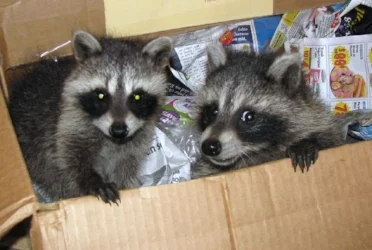Beyond Your Backyard: How Fireworks, Balloons and Litter Threaten our Wildlife.
Orphaned possums, "Jack, Chrissi and Janet". Orphaned wildlife that are rehabbed are kept wild so that they remain fearful of humans. These babies were successfully released. Photo courtesy of Educator and Rehabber, Mark Rosenthal
Kimberly J. Epp
As Canada Day (and the 4th of July) approaches, people are heading out to buy fireworks for their own personal celebrations. Towns and cities are preparing their ultimate fireworks presentations. But these fireworks, for their mere minutes of "Ooh's and Aah's", come at a terrible price for our wildlife, the environment - and even your pets.
Orphaned baby Red Squirrels. Photo by Educator and Rehabber, Mark Rosenthal.
The panic wild animals feel as the result of banging fireworks, for example, can cause wild mothers to abandon their babies. These babies can then become prey to cats and other predators. If "lucky", these traumatized young may end up in the care of a wildlife rehabber. Of course, they would be luckier if they didn't become orphaned in the first place. Squirrels, other small mammals, birds and butterflies have all been shown to become traumatized, and to exhibit life-threatening behaviour. Waterfowl can die after ingesting water littered with fireworks debris. All for mere minutes of "fun".
Orphaned raccoon kits. Looking a bit mischievous! Photo by Educator and Rehabber, Mark Rosenthal
If you think you have found orphaned wildlife, please call the Wildlife Rehabilitation Society of Saskatchewan at (306) 242-7177. They will then get in contact with a rehabber near you, and direct you in what to do. If you don't live in Saskatchewan, call your Provincial or State wildlife rehabilitation organization. A Google search will guide you on where to call.
Huddling orphaned baby gophers. Photo courtesy of "Living Sky Wildlife Rehabilitation", Saskatoon. Rehabbers know how important it is to keep the babies calm, warm and comforted.
Fireworks are detrimental to the environment. The chemical reactions that create the bursts of color release numerous by-products into the atmosphere. These toxins are like cancer-causing dioxins. The gunpowder used to launch the fireworks leave behind potassium carbonate, potassium sulphate and sulphide, sulphur and fine particulates. These also enter the local waterways and soil.
Even fourteen hours after a large fireworks display, levels of a chemical called perchlorate, a known chemical harmful to both people and wildlife, have been shown to be 1,000 times higher than usual. It can take up to 80 days for these levels to return to normal. Still like those fireworks?
Orphaned baby chickadee. Photo courtesy of "Living Sky Wildlife Rehabilitation", Saskatoon. I'm sure he misses his "banditry". Chickadees live in family groups of up to 10 birds.
Last weekend, I picked up pieces of balloons at the Regina Display Pond. Those balloons didn't go to "Heaven". Instead, balloons can become hell on earth for birds. So please, never release balloons or lanterns. They are not biodegradable. They return to land or water as litter, and cause the starvation and death of animals like birds and turtles. Their ribbons can cause the entanglement and strangulation of these animals. They become death traps to many creatures. Just one balloon can take the life of one bird.
Gum thrown onto the ground looks like bread to birds. It fills their entire system and prevents them from gaining any nourishment from food or water. They die a slow death due to starvation. Let's be more responsible with our trash. You can also do your part by carrying a bag with you when you head out to natural areas, and pick up the trash you see. By doing so, you may save some lives.
Please feel free to share this far and wide - and consider celebrating the upcoming holidays in an environmentally ethical way.
-----------------------------------------------------------------------
Epp is an Environmental Educator and Writer. She is also the President of the Moose Jaw Nature Society. She can be reached at kepp@shaw.ca.





